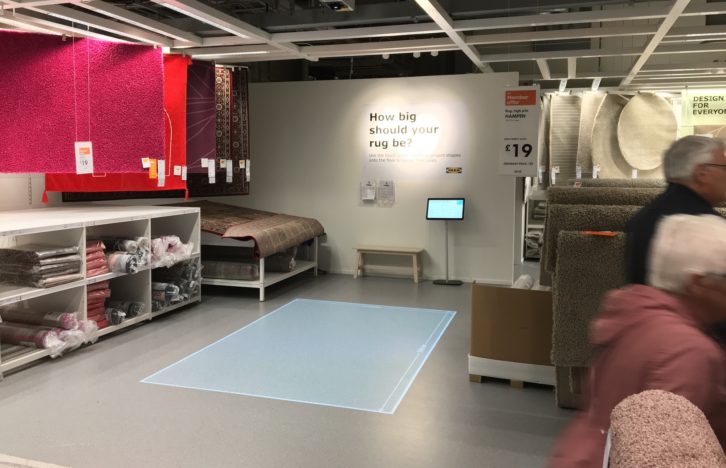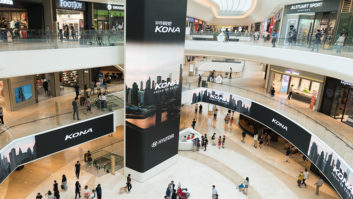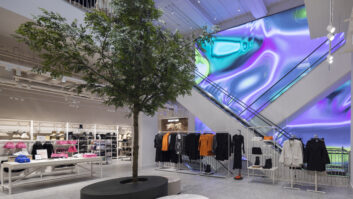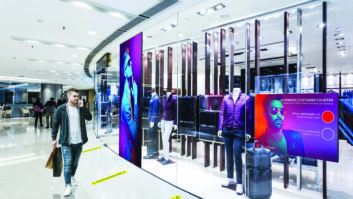
The highly competitive and volatile nature of high street retail is placing huge pressure on retailers to constantly innovate and create ways to improve their operational efficiency as well as the customer experience. Technology is at the heart of these improvements (with digital signage the most visible), with AV manufacturers and integrators central to what is fast becoming an evolution, perhaps even a revolution, in high street retail.
“With supermarkets consistently involved in price wars and bricks and mortar stores struggling to compete with e-commerce alternatives, it’s no secret that the high street is facing its most difficult time yet,” says Gary Byrne, business development manager Panasonic Retail Solutions. “In 2018, Britain saw over 1,500 stores suffer as a result of Company Voluntary Arrangements (CVAs), administrations, and store closures. It was a bad year for some of our British favourites, including House of Fraser, Next, Marks & Spencer and Debenhams.”
Alongside front-end AV solutions such as digital signage, shopper analytics, electronic shelf labelling (ESL) and stock management can improve operational efficiency, making huge cost savings and driving an increase in revenue. These efficiencies could ultimately lead to full automation of the retail sector, bringing bricks and mortar retailers closer to online retail’s modus operandi, creating new ‘stores of the future’ able to withstand market changes more easily.
Real-time pricing
“Retail solutions such as ESL means that prices can be managed in real-time, speeding up any changes, making it easier to dynamically price match, highlight promotions and reduce the risk of human error associated with managing price labels manually,” adds Byrne. “ESL enables shelf edge automation processes (dynamic pricing, stock and inventory management) and innovative new contactless marketing services such as self-scan to pay, geo-location, customer identification and targeted offers.”
Electronic shelf labelling is one of the most crucial technologies to improve operational efficiency, doing away with the need for the menial, manual and time consuming task of marking-down using a gun. The central management system automatically adjusts, making a multitude of savings for the retailer in the long run, despite the initial up-front costs.
“AI and machine learning is a key trend,” explains Emma Bigg, director at consultants Octavius RE. “Retailers have been capturing customer data for years, but by using AI to steer the buying process with a ‘visualise before you buy’ set up and add the machine learning side, you are able to capture and process this data more quickly and have a deeper understanding of customer behaviour.”
This allows retailers to streamline their inventory levels and also their logistics. Combining this with in-store devices to capture footfall, capacity, lighting levels, sound etc, and this data can offer new ways of introducing efficiency while also improving customer experience.
Of course, immersive customer experiences are at the heart of much of the deployment of the more visible aspects of in-store technology, such as digital signage and interactive touch displays.
“Immersive is the way forward,” says Steve Blyth, MD at Engage Works. “With younger generations socialising publicly about every part of their lives, retailers have to come up with new innovative ways to keep their target market engaged.
“The main challenge for any retailer is to give excellent experiences, but in a cost efficient way. Integrating digital signage gives retailers greater control over the exterior look and feel of the store, and eye-catching and ‘Instagramable’ moments are key.
“There used to be a time where taking photos in a store was frowned upon. Now, of course, retailers are encouraging customers to publicise their goods even if they don’t purchase. Stores that continually invest in innovative ways of thinking, and developing new ideas keep consumers engaged, gaining publicity via digital or word of mouth, giving them a greater return on investment.”
Active engagement
Digital signage is certainly helping retailers to deliver a more holistic retail journey: generating active engagement along all the steps of the purchasing decision, and driving the behaviour of the shopper. “In the retail sector, we are seeing significant growth in demand for display technologies in all categories,” explains Thomas Walter, section manager strategic product marketing, NEC Display Solutions Europe. “These include Large Format Displays and videowalls, dvLED and even projection – where laser as a light source has made it more attractive for signage applications with its long life durability and brightness.”
“At present retailers are deploying digital signage without the intelligence and insights required to measure success”
Smaller retailers prefer simple, easy to operate digital signage solutions; bigger organisations strive for holistic marketing tools that provide targeted customer communication paired with real-time analytics and campaign optimisation, helping to improve efficiencies.
“Huge visual surfaces help to draw people into stores,” adds Walter. “These are mainly using NEC dvLED technology often in flagship stores at present, but likely to be rolled out further in the future. Once inside the store, convincing messaging and consultancy is offered with access to more detailed product information and insight via LFD screens. And by moving to digital from traditional paper-based communications, organisations can save time and resources by instantly updating content according to daily and seasonal changes for more efficient and targeted communications.”
KFC, for instance, uses embedded RPi computing in its menu-boards to ensure reliable and seamless delivery of content, with instant updates – illustrating that, when it comes to digital display technology, it’s not all about customer experience.
“We are seeing an increasing number of retailers addressing the need to better train and retain their employees using digital signage in staff canteens and breakout areas in the store,” says Jason Cremins, founder and CEO at Signagelive. “The advance in digital signage hardware including System On Chip displays has greatly reduced the costs and complexity to deploy and manage internal communications within a store network. Interactivity can be added using the remote control supplied with SoC displays to select specific content to assist with staff on-boarding and product training, all of which can be tracked and reported on for compliance.
“There is also a considerable amount of interest and activity from retailers looking to use business intelligence to optimise the content they are showing on their digital signage displays. Audience Measurement through Annonoumus Video Analytics and Mobile Proximity can be used to profile customers and tailor content to ensure maximum impact.”
However, Cremins believes that most retailers have a long way to go before they can fully exploit and benefit from digital signage. “At present retailers are deploying digital signage without the intelligence and insights required to measure success,” he explains. “I believe the deployment of BI-driven digital signage in retail will become mandatory to prove the success and continued investment in digital signage in retail and not restrict deployments to flagship locations in major cities for high-value retailers.”
www.engageworks.com
www.macom.de/en
www.nec-display-solutions.com
www.octaviusre.com
https://business.panasonic.co.uk
www.signagelive.com







